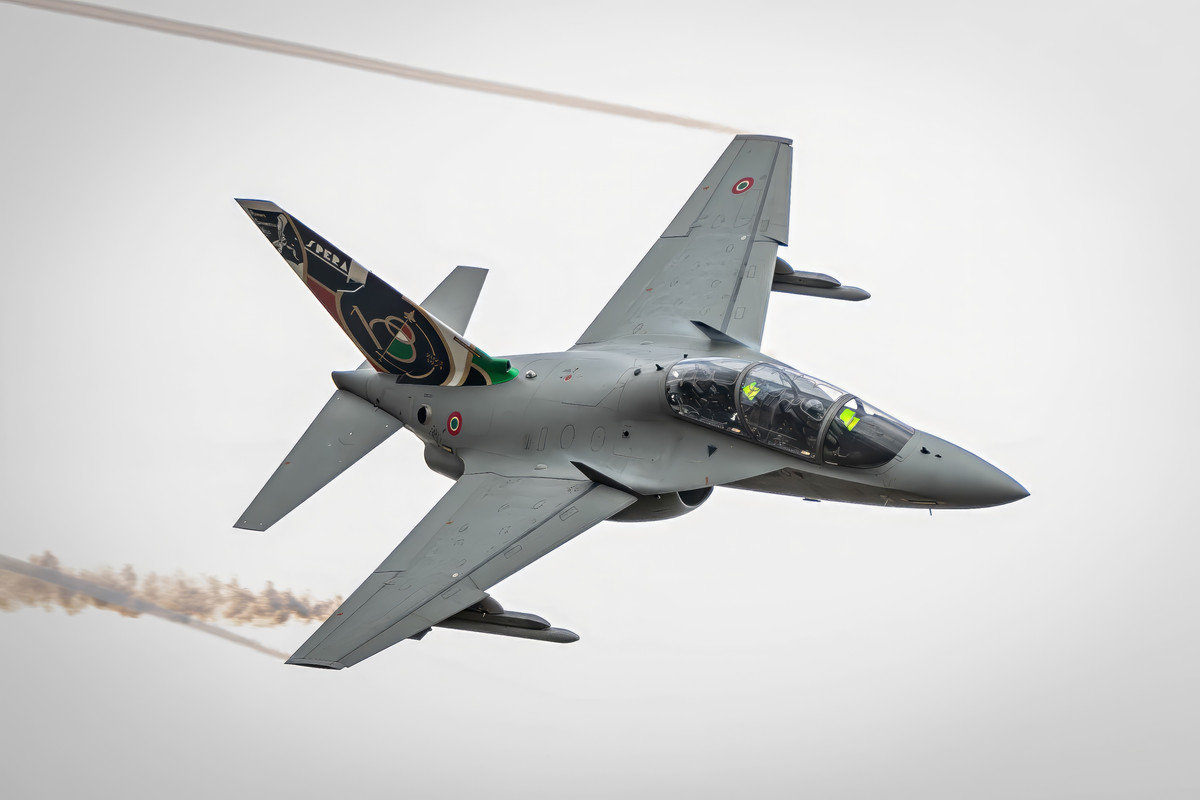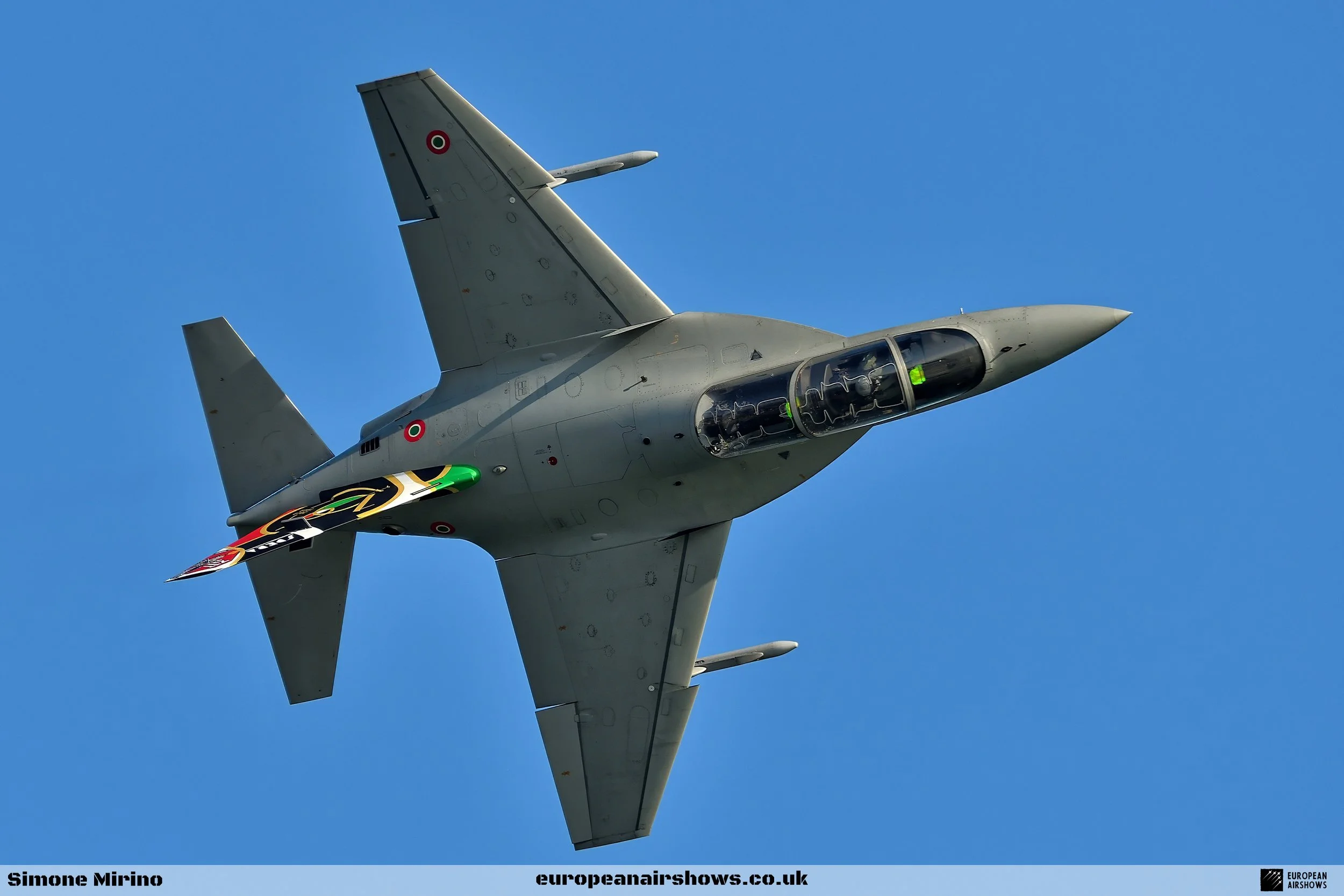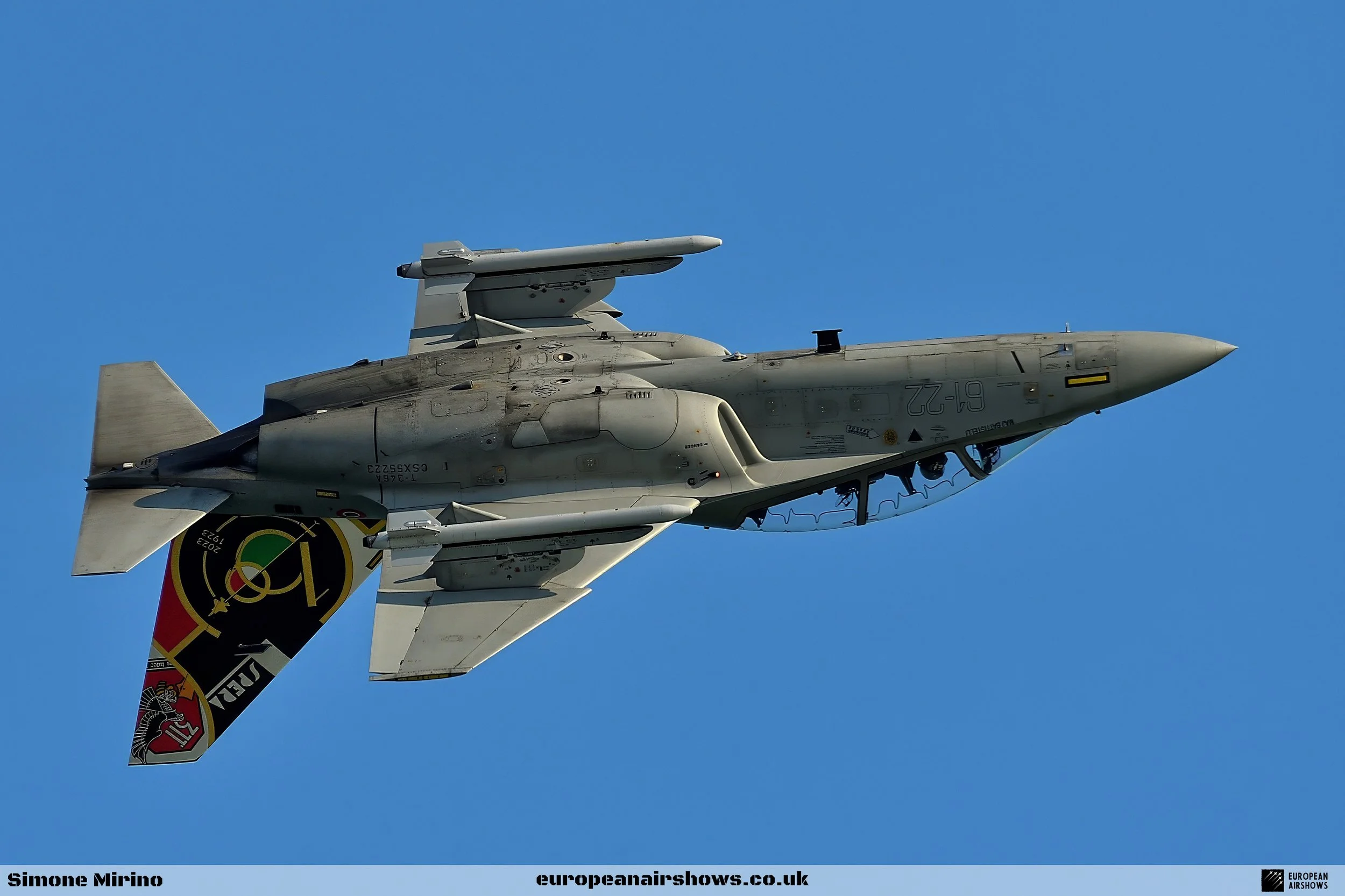
Italian Air Force T-346A Master solo display
T-346A Master solo display
The Italian Air Force T-346A Master solo display offers a striking demonstration of the aircraft's exceptional agility and cutting-edge design. Flown by a highly trained pilot from the 311° Gruppo Volo, part of the renowned Reparto Sperimentale Volo (Experimental Flight Unit), the performance showcases the T-346A’s prowess as a premier advanced jet trainer.
The display features a series of meticulously executed maneuvers that emphasize the aircraft’s superior handling and performance. Audiences witness an impressive repertoire, including tight loops, sharp rolls, Cuban 8s, inverted flight, and contrasting slow and high-speed passes, highlighting the aircraft’s versatility and responsiveness.
Adding to the spectacle, the T-346A is equipped with smoke pods beneath its wings, releasing streams of white smoke during the performance. This visual enhancement traces the aircraft’s path through the sky, accentuating the precision and fluidity of each maneuver, elevating the display into a mesmerizing blend of technical mastery and aesthetic flair.
About the T-346A Master
The Alenia Aermacchi M-346 Master, also known as the T-346A in Italian Air Force service, is a family of military twin-engine transonic advanced jet trainers and light combat aircraft. Its origins trace back to a joint venture in 1993 between Italy’s Aermacchi and Russia’s Yakovlev, initially developing the Yak/AEM-130 as a successor to aging trainers like the Aermacchi MB-339 and Soviet L-39 Albatros. The partnership dissolved in 2000 due to differing priorities and Russia’s financial constraints, leading Aermacchi to independently refine the design into the M-346 Master. The first prototype rolled out on June 7, 2003, and completed its maiden flight on July 15, 2004, powered by two Honeywell F124-GA-200 turbofan engines and featuring advanced Western avionics, including a fly-by-wire flight control system.
Development progressed rapidly, with the M-346 achieving significant milestones, such as breaking the sound barrier (Mach 1.15) on December 18, 2008—the first Italian-built aircraft to do so in 50 years. Certified by Italy’s General Directorate for Aeronautical Armaments on June 20, 2011, the aircraft evolved beyond its trainer role with variants like the M-346FA (Fighter Attack), introduced in 2017, capable of ground attack and reconnaissance missions. The M-346 has been adopted by air forces worldwide, including Italy, Israel (designated "Lavi"), Poland ("Bielik"), Singapore, Greece, Qatar, and Turkmenistan, reflecting its versatility and appeal. Since 2016, the manufacturer, now Leonardo following a merger with Finmeccanica, has marketed it as a cutting-edge training and combat platform.
The M-346’s design emphasizes high maneuverability, with a wide flight envelope and a thrust-to-weight ratio mimicking next-generation fighters like the Eurofighter Typhoon and F-35. Its Embedded Tactical Training System (ETTS) allows pilots to simulate complex combat scenarios, enhancing its role as a lead-in fighter trainer. Despite setbacks, including the loss of prototypes in crashes (e.g., November 2011 near Dubai and March 2022 in the Italian Alps), the aircraft has logged over 100,000 flight hours globally by 2025. Its adaptability has kept it competitive, though it lost the U.S. T-X competition to Boeing’s T-7A Red Hawk in 2018.
Specifications
Crew
2
Length
11.49 m (37 ft 8 in)
Wingspan
9.72 m (31 ft 11 in)
Height
4.76 m (15 ft 7 in)
Max Speed
1,090 km/h (680 mph, 590 kn)
Range
1,925 km (1,196 mi, 1,039 nmi)
Service Ceiling
13,716 m (45,000 ft)
g limits
+8 to -3
T-346A Master in the Italian Air Force
The Italian Air Force (Aeronautica Militare) was the launch customer for the M-346, designating it the T-346A. The service ordered an initial batch of 15 aircraft, with the first two delivered on December 21, 2010, at Leonardo’s Venegono facility. These were assigned to the Reparto Sperimentale Volo (Experimental Flight Unit) at Pratica di Mare airbase for operational evaluation, with the first T-346A flight occurring on March 31, 2011. By February 2018, deliveries reached 18 aircraft, and in 2024, Italy ordered 20 more—15 for the Frecce Tricolori aerobatic team to replace the MB-339A PAN and 5 for the International Flight Training School (IFTS). The T-346A serves as the final training stage before pilots transition to frontline fighters, based primarily at Lecce-Galatina and later Decimomannu in Sardinia.
The IFTS, a collaboration between the Italian Air Force and Leonardo, leverages the T-346A fleet (18 from the air force and 4 from Leonardo) to train pilots from nations like Qatar, Japan, Germany, and the UK, delivering 8,000 flight hours annually. The aircraft’s advanced features, such as its fly-by-wire system and Helmet Mounted Display, prepare pilots for modern combat aircraft. A notable incident occurred on March 16, 2022, when a T-346A crashed on Mount Legnone, highlighting operational risks, though the fleet’s safety record remains strong. The planned integration into the Frecce Tricolori, announced on September 12, 2024, with a new Pininfarina-designed livery, underscores its growing role in both training and national prestige.
Did You Know?
- The M-346 Master’s cockpit canopy is made from a single piece of acrylic, offering pilots an unobstructed 360-degree view—unusual for a trainer—and enhancing situational awareness during complex maneuvers.
- Its fly-by-wire system was tested to mimic the handling of a Eurofighter Typhoon so precisely that pilots transitioning to the Typhoon reported almost no adjustment period, a rare feat for a trainer aircraft.
- The M-346 can carry a podded 12.7mm machine gun or even a 20mm cannon for light attack roles, a capability not typically found in advanced jet trainers, blurring the line between trainer and combat aircraft.
- In 2013, an M-346 prototype accidentally performed an unscripted 9g maneuver during a test flight—exceeding its +8g design limit—yet sustained no structural damage, showcasing its robust airframe.
- The aircraft’s Embedded Tactical Training System (ETTS) can simulate the radar signature and weapon systems of an F-35, allowing trainees to practice against virtual stealth fighters without leaving the cockpit.
Test Your Knowledge
1. What is the M-346 Master’s maximum range without external fuel tanks?





















